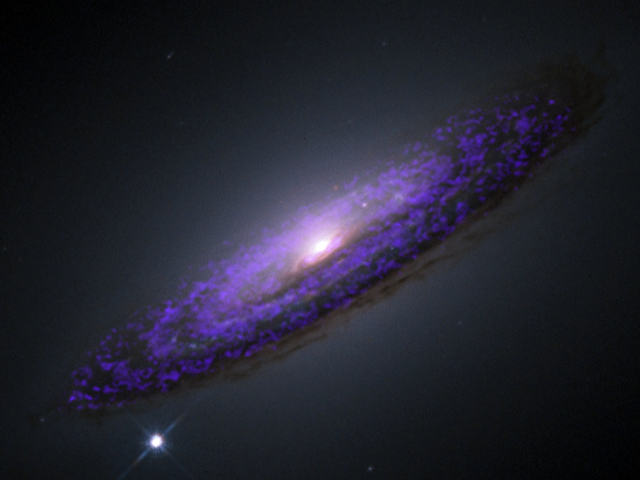
The data is good: nearly every large galaxy has at least one supermassive black hole in its nucleus. The data is bad: there generally seems to be a connection between the mass of the black hole and the size of the galaxy's bulge, at least for many galaxies. And the data is ugly: accurate direct measurements of black hole masses are hard to come by, since they're buried deep in the middle of their host galaxies.
A promising technique has used gas dynamics in the galaxy as a black hole mass tracer, as proposed by Timothy A. Davis, Martin Bureau, Michele Cappellari, Marc Sarzi, and Leo Blitz. They tested their hypothesis on a galaxy that has a large amount of carbon monoxide emissions, prime for observations with submillimeter observatories. This method requires far less observation time than many other techniques, meaning that many supermassive black holes could potentially be surveyed.
Measuring supermassive black hole (SMBH) masses is not always straightforward. Astronomers can estimate masses by tracking stars in the central regions of galaxies as they orbit the black hole or by mapping emission by nearby ionized gas. Another promising method used X-ray and radio light for the most massive galaxies in the Universe. But these techniques aren't possible for all galaxies
Molecular gas, however, is present in a large number of galaxies, and many molecules emit at wavelengths that can provide high-resolution looks into the regions near SMBHs. These molecules include hydrogen (H2) and carbon monoxide (CO). The latter is particularly interesting, because it emits light in the submillimeter range, the portion of the electromagnetic spectrum lying at the boundary between infrared and microwave light.
Gas near galactic centers moves under a variety of gravitational influence, including the internal gravitational attraction of the gas cloud itself. If the galaxy is host to a SMBH, then it will contribute to the gas motion—its kinematics—as well. The motion of the gas can be measured through the Doppler effect, the shifting of the wavelengths due to the gas' velocity relative to Earth.
The authors of the new study measured CO emission from the galaxy NGC 4526. This is a lenticular (lentil-shaped) galaxy—effectively a spiral galaxy with no spiral arms. Due to its shape, NGC 4526 has a clearly defined central bulge, and that's where the influence of a SMBH would be felt by the molecular gas. The astronomers performed their observations with the Combined Array for Research in Millimetre Astronomy (CARMA), a set of six telescopes in California.
Using multiple telescopes in combination often provides higher resolution than individual telescopes can achieve. That allowed the authors to peer at the central region of NGC 4526 and create a full Doppler map of the CO motion.
From this map, they fit a variety of possible models that could explain the gas kinematics: no SMBH, or a range of possible SMBH mass values. This comparison allowed them to decisively rule out the "no SMBH" option, since that would imply more gas than they actually observed. The best fit to the data included a SMBH roughly 450 million times the mass of the Sun—a hefty black hole, but nowhere close to the biggest known specimen.
As with other gas measurements, the molecular gas observations could run into trouble if the black hole causes turbulence or if the rotation of the gas doesn't align with the stars of the bulge. For NGC 4526, this problem didn't seem to exist, but the authors warn that for other galaxies, it could lead to overestimates of the SMBH mass.
Besides the relative abundance of molecular gas in many galaxies, the method also has a striking advantage: short observation times. With arrays of submillimeter telescopes such as the Atacama Large Millimeter/Submillimeter Array (ALMA) in Chile, the researchers estimated a single black hole could be studied in 5 hours—an impressively short time. That opens up the possibility of performing SMBH surveys, collecting sufficient data to settle questions of black hole-galaxy interaction and coevolution.
Nature, 2013. DOI: 10.1038/nature11819 (About DOIs).
reader comments
17